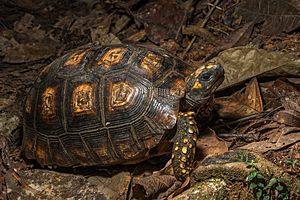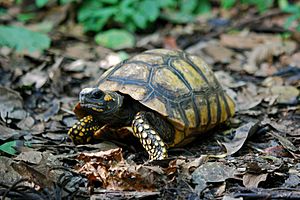Yellow-footed tortoise facts for kids
Quick facts for kids Yellow-footed tortoise |
|
|---|---|
 |
|
| Yellow-footed tortoise, Yasuni National Park, Ecuador | |
| Conservation status | |
| Scientific classification | |
| Genus: |
Chelonoidis
|
| Species: |
denticulatus
|
The yellow-footed tortoise (Chelonoidis denticulatus), also known as the Brazilian giant tortoise, is a large land turtle found in the Amazon Basin of South America. It is a close relative of the red-footed tortoise (C. carbonarius).
This tortoise is one of the biggest tortoise species on Earth! It usually grows to about 40 cm (15.75 in) long. The biggest one ever found was 94 cm (37 in) long. This makes it the sixth-largest tortoise species, after the Galapagos tortoise, the Aldabra tortoise, the African spurred tortoise, the leopard tortoise, and the Asian forest tortoise.
Contents
About the Yellow-Footed Tortoise
The yellow-footed tortoise has many names! People also call it the yellow-foot or yellow-legged tortoise, the Brazilian giant tortoise, or the South American forest tortoise. In some local areas, it's known as morrocoy, woyamou, or jabuta. Many of these local names are also used for its cousin, the red-footed tortoise.
Scientists group animals to understand them better. This is called taxonomy. In 1766, a famous scientist named Carl Linnaeus first named this tortoise Testudo denticulata. Testudo means "turtle," and denticulata means "tooth-like," which refers to the slightly jagged edges of its shell. Over time, scientists learned more about tortoises and gave them new names to show how they are related to each other.
Today, the yellow-footed tortoise belongs to the genus Chelonoidis. This group includes tortoises from South America. They have special features, like not having a small shell plate (called a nuchal scute) over their neck, and having a single large plate (called a supracaudal) over their tail.
Physical Features and Appearance
Yellow-footed tortoises are quite large. They are the fifth-largest tortoise overall and the third-largest found on land. They look a lot like red-footed tortoises, and it can sometimes be tricky to tell them apart.
Their top shell, called the carapace, is a long oval shape. It has a high, rounded back. The shell is usually yellowish-brown to dark brown or even black around the edges of its plates, called scutes. The center of each scute is often pale yellow, orange, or light brown.
The bottom shell, called the plastron, is thick. It is yellow-brown and gets darker, almost black, near the lines where the scutes meet.
The tortoise's head is small and longer than it is wide. Its upper jaw has three points that look like teeth. They have large black eyes, and behind each eye, there's a tympanum, which is like an eardrum. The skin on their head and legs is black, with yellow or orange scales on top and around their eyes and ears. Their front legs have five claws and are covered with small, dark scales. Their back legs are thick, like an elephant's, with four claws.
How Males and Females Differ
Adult male yellow-footed tortoises are usually a bit bigger than females. However, the very largest tortoises found are often females. Males have a special "waist" shape on their shell, where the sides curve inward. Their bottom shell (plastron) also curves inward more deeply. Females have a short, cone-shaped tail, while males have a longer, stronger tail that they usually keep tucked to one side.
Natural Home
Yellow-footed tortoises live in different types of places. Some scientists think they prefer grasslands and dry forests, while others believe they like humid forests. No matter what, you can find them in drier forest areas, grasslands, savannas, or rainforests that are next to more open areas. The red-footed tortoise also lives in some of the same places. In some areas, red-footed tortoises have moved into grasslands, while yellow-footed tortoises have stayed in the forests.
Behavior
These tortoises make interesting sounds, like a baby cooing with a rough voice. They also use body language to recognize each other. Male tortoises move their heads in a special way when they see other males. Females do not do this. Males also swing their heads back and forth in a steady rhythm as part of their mating ritual.
Diet

The yellow-footed tortoise eats many different kinds of plants. They are too slow to catch fast animals. In the wild, they eat grasses, fallen fruit, dead animals (called carrion), other plants, bones, mushrooms, and slow-moving creatures like snails and worms.
When kept by humans, they eat fruits like oranges, apples, and melons. They also eat leafy greens like endive, collard greens, and dandelions. They can eat shredded carrots, insects, worms, and special tortoise vitamins.
Reproduction and Life Cycle
Yellow-footed tortoises become adults and can have babies when they are about 8 to 10 years old. Female tortoises usually lay more eggs if they are bigger. On average, a female will lay about 6 to 16 eggs each year, but some females might not lay eggs every year. The eggs have thin shells and are round or oval, about 3 to 6 cm (1.2 to 2.4 in) across. Bigger tortoises lay bigger eggs.
Breeding often happens when the rainy season starts, usually from July to September. During this time, tortoises become more active. Males recognize other males by making a special head movement, jerking their head away and back to the middle. If another tortoise doesn't make this movement back, it's likely a female.
During courtship, the male makes clucking sounds, much like a chicken. Male tortoises will sometimes fight each other, trying to flip their opponent over. However, neither males nor females protect a specific area of land. They tend to move around a lot. In most tortoise species where males fight, the males are usually larger than the females. This is because larger males have a better chance of winning a fight and mating, passing on their genes for larger size.
Baby tortoises are on their own from the moment they hatch. They start by eating plants rich in calcium. Yellow-footed tortoises can live for a long time, usually around 50 to 60 years!
Conservation Status
The yellow-footed tortoise is considered an endangered species. This means their numbers are decreasing, and they need protection. The main groups of these tortoises in South America are protected by an agreement called the Convention on International Trade in Endangered Species (CITES), under Appendix II. This means that trading them across borders is controlled to help protect them.
Sadly, like many turtles and tortoises, many yellow-footed tortoises are caught and sold for food in local markets. They are also popular in the pet trade, which can also affect their numbers in the wild.
|
See also
In Spanish: Tortuga de patas amarillas para niños



